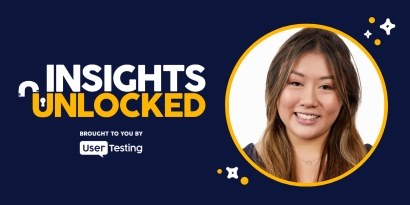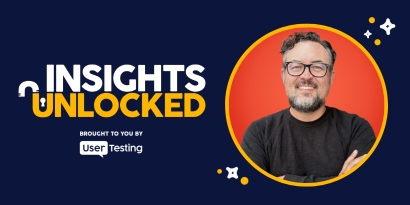
Episode 108 | March 11, 2024
Supercharge your research with intentional and connected note-taking
In this Insights Unlocked episode, UserTesting’s Lija Hogan talks with Jorge Arango, author of the new book Duly Noted: Extend Your Mind Through Connected Notes. They discuss the power of note-taking to help you be more knowledgeable and creative, both at a personal level and collaboratively with teams.
Supercharge your research with intentional (and connected) note-taking
Notes permeate our lives, whether you are a researcher, designer, Fortune 100 CEO, small business owner, stay-at-home parent or aspiring college student.
But have you ever considered how we take notes? What’s noteworthy and what isn’t? Where do we keep notes? How do we reference them later on? And what’s the difference between a transient note (grocery list) and an evergreen note (insights from a customer interview)?
In this Insights Unlocked episode, UserTesting’s Lija Hogan talks with Jorge Arango, author of the new book Duly Noted: Extend Your Mind Through Connected Notes. They discuss the power of note-taking to help you be more knowledgeable and creative, both at a personal level and collaboratively with teams.
Jorge boils it down to three simple rules:
- Make short notes
- Connect your notes
- Nurture your notes
Jorge is the author of Living in Information: Responsible Design for Digital Places, co-author of Information Architecture: for the Web and Beyond, and host of The Informed Life podcast. In addition to consulting, writing, and podcasting, Jorge also teaches at California College of the Arts in the graduate interaction design program.
Jorge said capturing an idea or thought in a notebook (whether paper or digital) is a part of your thinking process.

“Thinking with paper and note-taking is a form of thinking,” he said. “Thinking doesn’t happen exclusively in the brain, and notes are a very convenient and accessible thinking mechanism. It is a way of expanding our cognitive abilities.”
Transient vs. evergreen notes
In the book, Jorge describes two basic types of notes.
The first is transient notes such as a grocery list or a reminder to pick up the dry cleaning. While important in the moment, it isn’t necessary to keep them forever.
The other type is evergreen notes. These could be a quote you heard in a lecture, a piece of research from a book or news article, or an insight from a customer interview. They are important to your current self, and they can be important to your future self who reads the note in a few weeks, months, or years from now.

“If you have the ability to search back or browse through the notes you've taken down, then all of a sudden you have this repository that can stick around for a while and that doesn't take up space in your bookshelves,” he said.
Note-taking versus note-making
As discussed above, not all notes are the same. Another distinction is the processes of note-taking and note-making.
Note-taking is capturing what a customer may say in a Live Conversation; or that quote you took during Andy MacMillan’s keynote at THiS in Seattle last year. It’s the researcher's observation while watching a customer make a cup of coffee in a field study.
Note-making is annotating new thoughts and ideas inspired by earlier note-taking. As Jorge says in his book, “You write down what you’re thinking to make sense of your ideas.”
Building your digital knowledge garden
Taking advantage of digital tools allows us to break free from the limitations of physical notebooks, Jorge said. We’re then able to store, search, and connect our notes; creating a knowledge garden that supports the development of ideas both individually and collaboratively.
He said there is little reason to get rid of stuff given the amount of storage our computers have today. “There's no reason to ever delete anything ever again,” he said. “If you have the ability to search back or browse through the things that you've taken, the notes that you've taken down, then all of a sudden you have this repository that can stick around for a while and that doesn't take space in your bookshelves.”

“And that's effectively what I mean by a knowledge garden,” Jorge said. “It's a knowledge graph of notes that you've taken on different subjects that are connected in ways that allow you to extract more meaning through connections, spotting patterns, finding insights in ways that you would not be able to do if you were just writing stuff by hand and stuffing notebooks on a shelf.”
Collaborating with notes for shared genius
Maintaining a knowledge garden doesn’t have to be a solo act, Jorge writes in the book. Tools like shared digital whiteboards enhance team communication and collaboration, providing a visual space for collective understanding and real-time synthesis during research interviews.
There are numerous arguments for and against taking notes during user interviews. Even when you have a note-taker, there are things only you may catch being the one who is moderating, and things they may catch being an observer.
As you launch a collaborative note-taking session, project or program, Jorge suggests setting some up-front planning, such as how things should be grouped or named.
The AI Debate: partner or plagiarist?
Jorge sees generative language models (like ChatGPT) as revolutionary, “I don't think I'm exaggerating by saying that this might be one of the most useful tools ever invented,” he said.
He acknowledges the dangers alongside the incredible potential. Jorge acknowledges how rapidly generative AI is evolving, but suggests adopting guidelines for how we use it.

He paraphrases Simon Wilson, who said, “You shouldn't publish something that takes a longer time to read than it did to create. That seems like a good guideline to follow, right?” Jorge said. “And what that implies is don't just publish this stuff that the AI spits out. Use it as a thinking tool so that you can write something better.”
He advocates for a middle ground between total reliance on AI and ignoring it altogether. He sees it as a tool to enhance the user's thinking, not something that replaces the writer completely.
Episode links:
- Duly Noted: Extend Your Mind Through Connected Notes by Jorge Arango
- Jorge’s website
- Jorge Arango on LinkedIn
- Jorge’s podcast, The Informed Life
- Lija Hogan on LinkedIn
- Figure It Out by Karl Fast and Stephen Anderson
- Simon Wilson weblog (AI industry observer)
- Sam Ladner on LinkedIn
- Digital whiteboarding tools: Miro, FigJam, Mural
- Note-taking apps: Obsidian, Notion, Evernote










